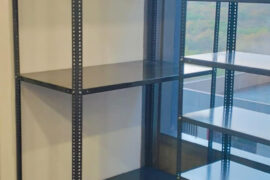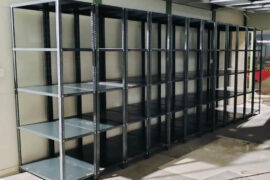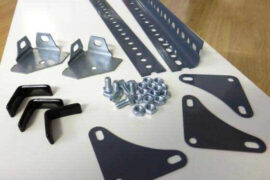Slotted angle racks are a versatile and widely used storage solution across various industries, from retail stores to warehouses. Their flexibility, durability, and ease of assembly make them an ideal choice for businesses of all sizes. However, to fully utilize these racks, it’s crucial to understand their load-bearing capacities. This article will delve into the concept of load-bearing capacities of slotted angle racks, helping you make informed decisions about your storage needs and ensuring the safety and longevity of your racks.
For those in Pune looking for high-quality slotted angle racks, Rida Racks is a trusted supplier offering a wide range of products designed to meet your specific needs. Visit Rida Racks to explore their offerings and get expert advice on selecting the right racks for your business.
What is Load-Bearing Capacity?
Load-bearing capacity refers to the maximum weight that a structure, such as a slotted angle rack, can support without experiencing structural failure. Understanding the load-bearing capacities of slotted angle racks is essential to ensure that the racks can handle the weight of the items being stored safely.
When the load exceeds the rack’s capacity, it can lead to various issues such as bending, warping, or even complete collapse. These failures not only damage the stored goods but also pose serious safety hazards to employees and customers. Therefore, knowing the load-bearing capacity of your slotted angle racks is crucial for both operational efficiency and safety.
Factors Affecting Load-Bearing Capacities of Slotted Angle Racks
Several factors influence the load-bearing capacities of slotted angle racks. Understanding these factors will help you choose the right racks and use them effectively.
1. Material of the Racks
The material from which the slotted angle racks are made plays a significant role in determining their load-bearing capacity. Most slotted angle racks are made of steel, which provides excellent strength and durability. However, the quality of the steel can vary. High-quality, heavy-duty steel racks will have a higher load-bearing capacity compared to those made from lighter or lower-quality steel.
2. Thickness of the Angles and Shelves
The thickness of the angles and shelves used in the racks is another critical factor. Thicker steel provides greater strength and support, increasing the rack’s load-bearing capacity. Typically, slotted angle racks come in various thicknesses, ranging from 0.8mm to 3mm. For heavy-duty storage needs, it’s advisable to choose racks with thicker components.
3. Design and Construction
The design and construction of the slotted angle racks also impact their load-bearing capacities. Racks with more robust joints, additional bracing, or reinforced shelves will generally support more weight. The distribution of load across the shelves and the overall stability of the rack design play crucial roles in its load-bearing capacity.
4. Load Distribution
How the load is distributed across the shelves significantly affects the rack’s capacity. Even if a rack has a high load-bearing capacity, improper load distribution can lead to instability and failure. Heavier items should be placed on lower shelves, while lighter items should be stored higher up. Additionally, the load should be evenly spread across the shelves to prevent overloading one side of the rack.
5. Environmental Factors
Environmental conditions such as humidity, temperature, and exposure to chemicals can also affect the load-bearing capacities of slotted angle racks. Corrosion due to moisture or chemical exposure can weaken the steel, reducing its strength over time. In such environments, choosing racks with corrosion-resistant coatings or materials is essential.
Calculating the Load-Bearing Capacity
Determining the load-bearing capacities of slotted angle racks involves several steps. While manufacturers often provide load capacity ratings for their products, it’s important to understand how to calculate these capacities yourself to ensure safety and efficiency.
1. Manufacturer Specifications
Start by checking the manufacturer’s specifications for the slotted angle racks. These specifications usually include the maximum load capacity for each shelf and for the entire rack. Keep in mind that these ratings are based on evenly distributed loads and may vary depending on the configuration of the racks.
2. Consider Shelf and Rack Configurations
The configuration of the shelves and racks can impact the overall load-bearing capacity. For example, racks with more shelves may have a lower load capacity per shelf due to the distribution of weight across multiple points. Conversely, fewer shelves may allow each shelf to support more weight. Adjusting the number and spacing of shelves can help optimize the load-bearing capacity for your specific needs.
3. Calculate the Total Load
To calculate the total load-bearing capacity, sum the individual capacities of all the shelves. However, be cautious not to exceed the overall load capacity of the rack structure itself. For instance, if each shelf can hold 200 kg and the rack has five shelves, the total capacity might be 1,000 kg, but the rack’s overall capacity might only be rated for 800 kg. In such cases, you should not load the rack beyond its rated capacity.
4. Factor in Safety Margins
It’s wise to include a safety margin in your calculations. This means using only a percentage of the rated load-bearing capacity to account for potential variances in load distribution, material fatigue, and environmental conditions. A common safety margin is 80-90% of the rated capacity, providing an extra layer of security against overloading.
Common Mistakes to Avoid
When dealing with the load-bearing capacities of slotted angle racks, there are several common mistakes that can lead to unsafe conditions.
1. Overloading Racks
One of the most dangerous mistakes is overloading the racks beyond their rated capacity. This can lead to bending, warping, or even collapse, posing significant safety risks.
2. Improper Load Distribution
Placing all heavy items on one shelf or on one side of the rack can lead to instability and uneven stress on the rack components. Ensure that the load is evenly distributed across all shelves.
3. Ignoring Environmental Factors
Failing to consider the effects of environmental conditions such as humidity, temperature, or chemical exposure can lead to premature deterioration of the rack materials, reducing their load-bearing capacity.
4. Using Incompatible Components
Mixing components from different manufacturers or using incompatible angles and shelves can compromise the integrity of the rack structure. Always use components that are designed to work together and meet the required load specifications.
Ensuring Safety and Durability
Understanding and adhering to the load-bearing capacities of slotted angle racks is essential for maintaining a safe and efficient storage system. Here are some tips to ensure the longevity and safety of your racks:
1. Regular Inspections
Conduct regular inspections of your slotted angle racks to check for signs of wear, corrosion, or damage. Address any issues promptly to prevent accidents.
2. Proper Training
Ensure that all employees are trained on the proper use and loading of slotted angle racks. They should understand the importance of load distribution, load capacity limits, and safety protocols.
3. Use Quality Racks
Invest in high-quality slotted angle racks from reputable suppliers like Rida Racks. Quality racks are built to withstand heavy loads and adverse conditions, ensuring long-term reliability.
4. Maintenance and Repairs
Regular maintenance, such as tightening bolts, cleaning, and repainting, can help extend the life of your racks. If any components become damaged or worn, replace them immediately to maintain the structural integrity of the rack.
Conclusion
Understanding the load-bearing capacities of slotted angle racks is crucial for ensuring the safety, efficiency, and longevity of your storage system. By considering factors such as material quality, thickness, design, and load distribution, you can select the right racks for your needs and avoid common pitfalls. Regular inspections, proper training, and ongoing maintenance will further enhance the performance of your slotted angle racks.
For businesses in Pune seeking reliable and durable slotted angle racks, Rida Racks offers a wide range of options tailored to meet various storage requirements. With their commitment to quality and customer satisfaction, Rida Racks is your go-to supplier for all your storage needs. Visit Rida Racks today to explore their products and find the perfect solution for your business.



